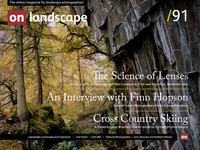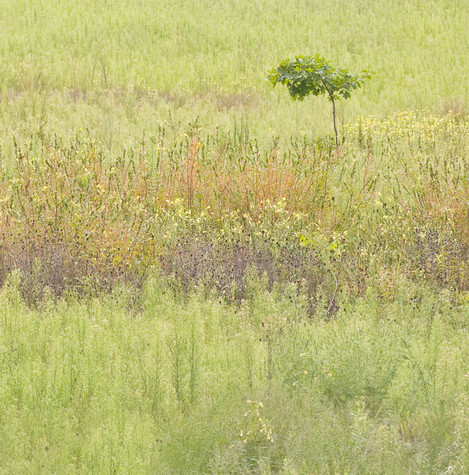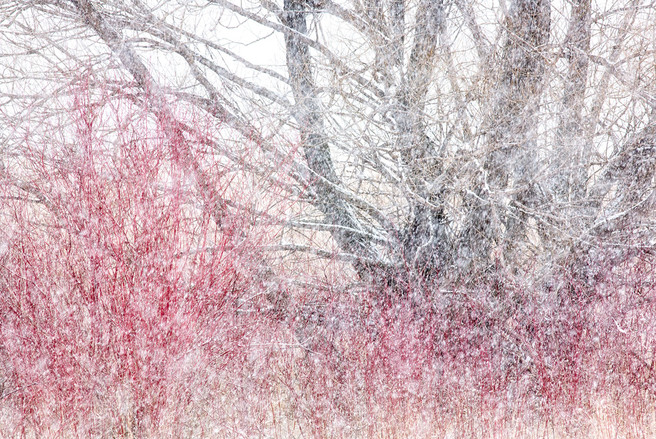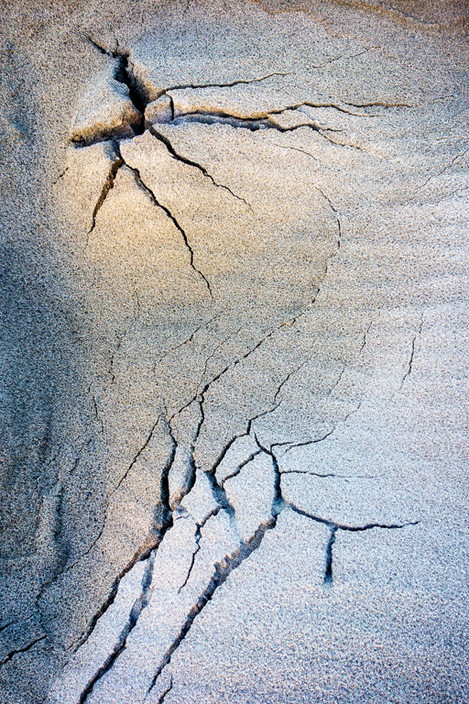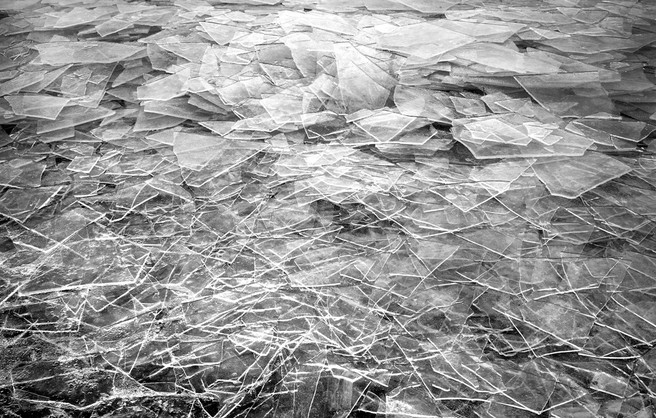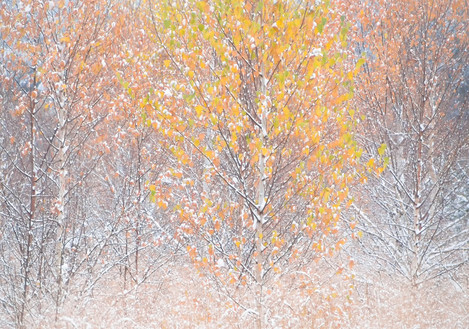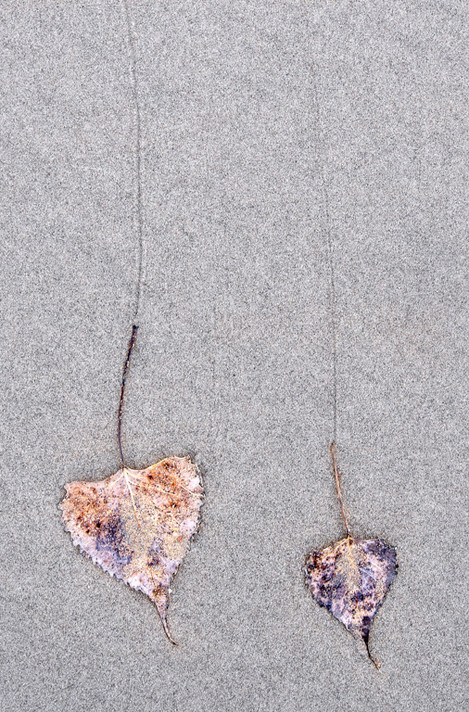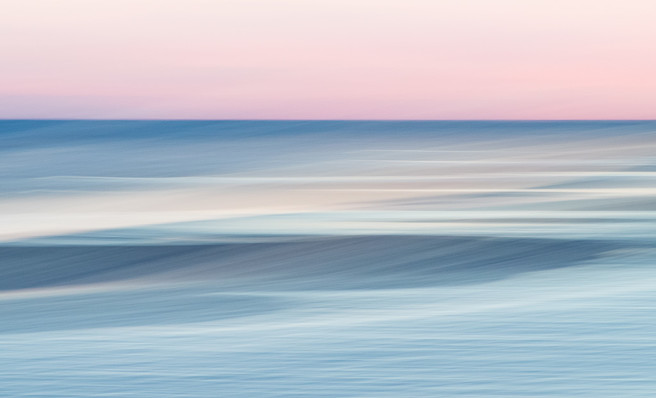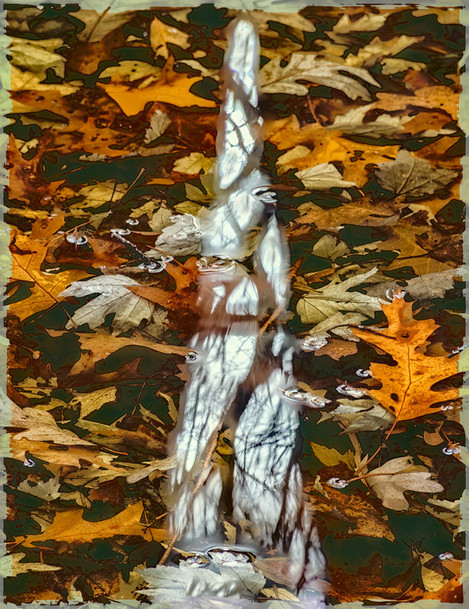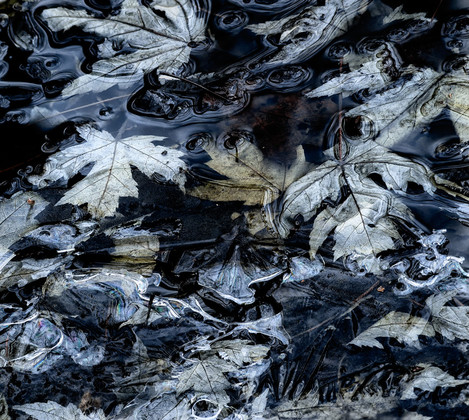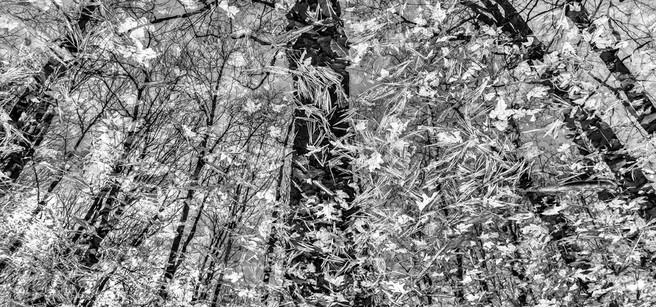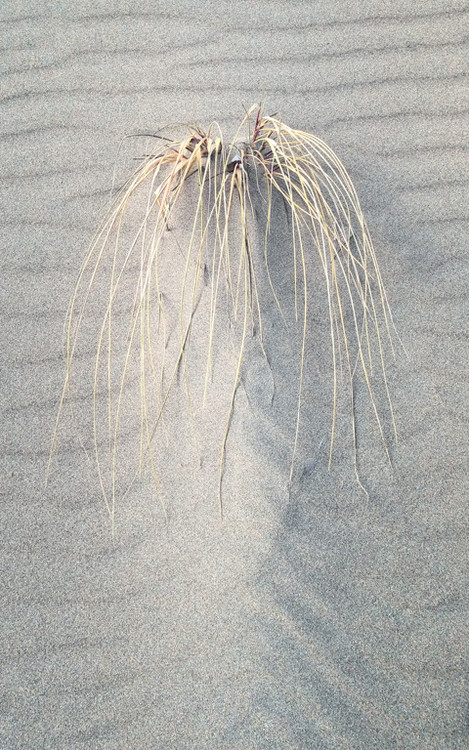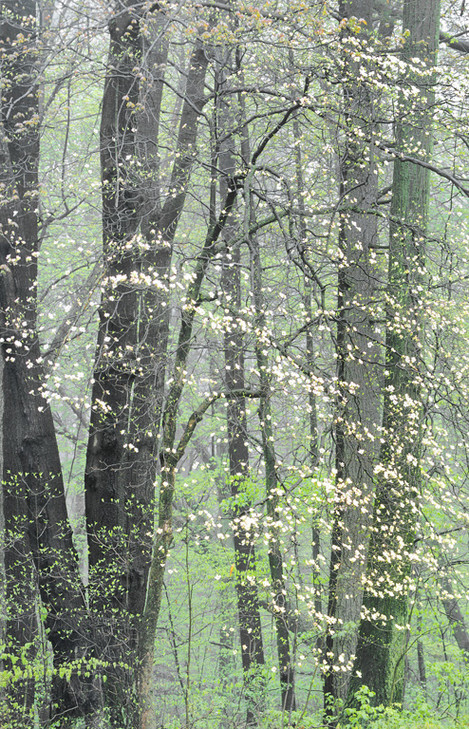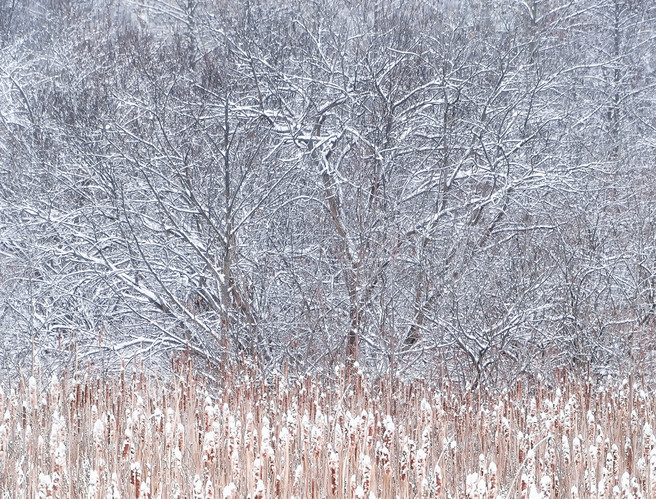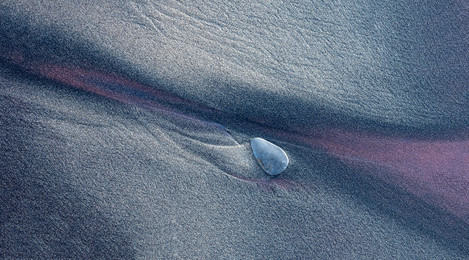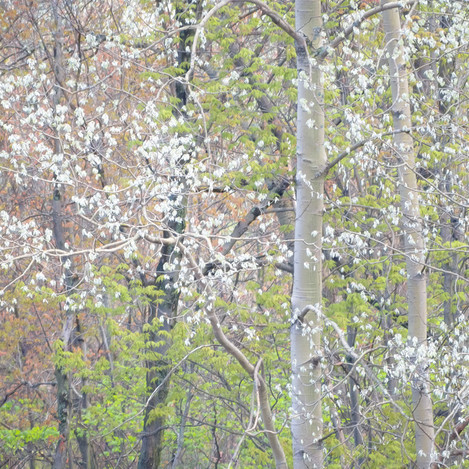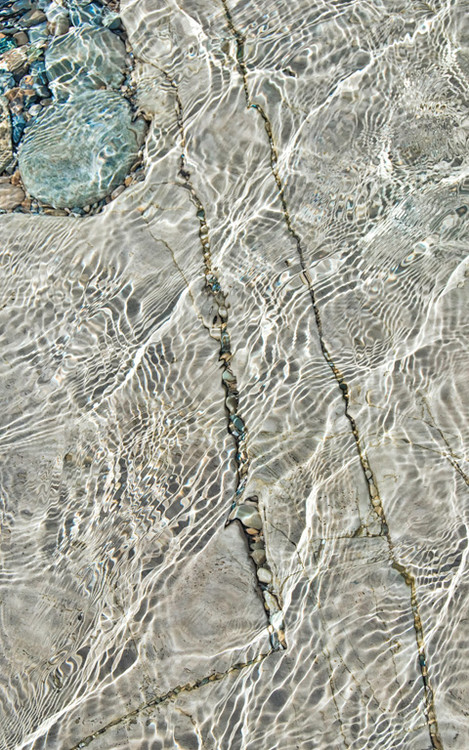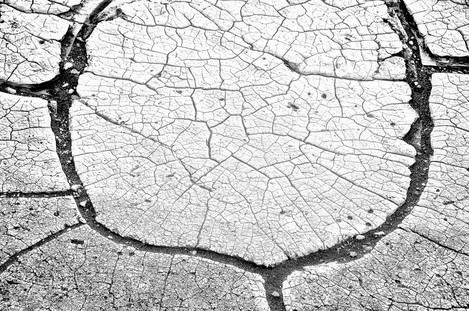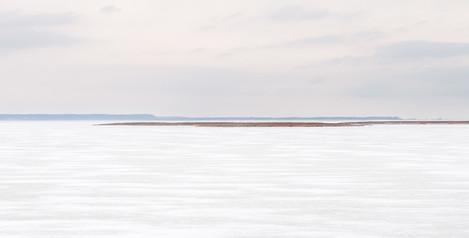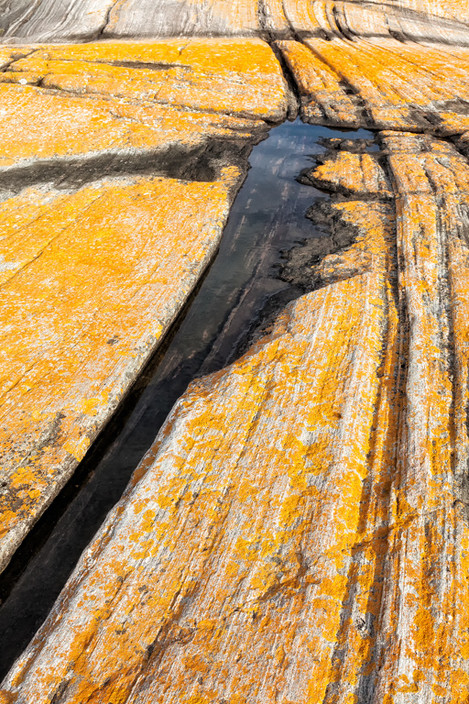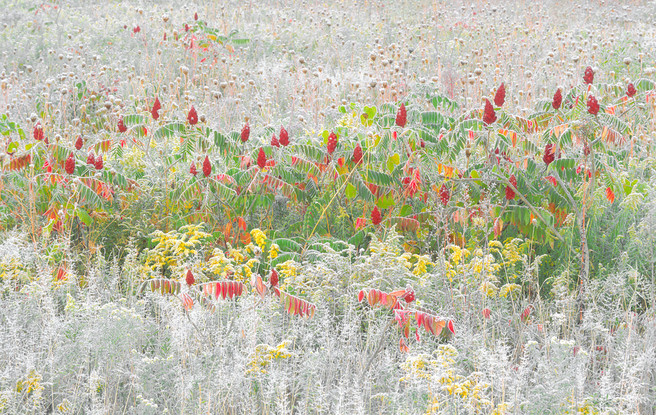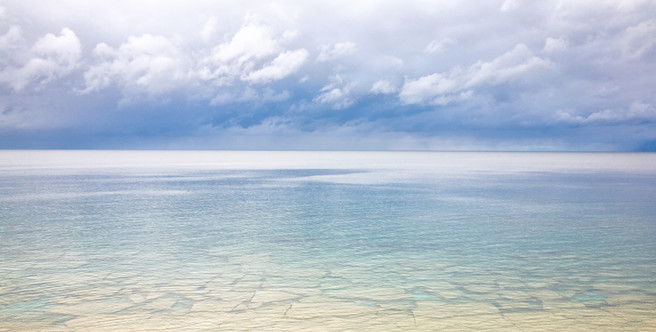Featured Photographer

Kathleen Pickard
One of my greatest pleasures in photography is uncovering the unfamiliar in the familiar. When I hear from a viewer that “I live here but I’ve never noticed that before!”, I smile in satisfaction. Beauty is often hiding in plain sight, but it takes practice to see it.

Larry Monczka
The excitement of discovery as I continue to explore the geography of home over the years and decades through the medium of photography sparks my creativity and enriches my life.

Michéla Griffith
In 2012 I paused by my local river and everything changed. I’ve moved away from what many expect photographs to be: my images deconstruct the literal and reimagine the subjective, reflecting the curiosity that water has inspired in my practice. Water has been my conduit: it has sharpened my vision, given me permission to experiment and continues to introduce me to new ways of seeing.
On this occasion, we have a joint interview with husband and wife Larry Monczka and Kathleen Pickard who live on the northern shore of Lake Erie in Norfolk County, Canada. Spring 2015 sees a joint exhibition of their photography called “Hereabouts” and they have published a book of the same name to coincide with this. I came across their work last year and found it appealed on a number of levels. They delight in finding the beauty in small things that are easily overlooked.
Congratulations on having the first solely photographic exhibition at the Norfolk Arts Centre. How established is photography as an art form locally?
We would have to say that photography hasn’t traditionally been considered an art form locally, and in some circles still isn’t. Added to this is that there is a reluctance in North America to accept nature art into the wider artistic community. I don’t know if that same attitude is present in the British art world. We both feel that it was a significant step forward in recognizing the artistic validity of photography when we were invited to do the first photographic exhibition ever held by that the Norfolk Arts Centre.
We have been part of the county Studio Tour for four years now, and our work has been accepted in local juried competitions and shown in local galleries, so we feel that we have slowly been finding our place in the local artist community. Our way forward has been to allow our work to speak for itself rather than advocating for it.
It’s easy to think that the “grass is greener on the other side” but your images do suggest a bountiful range of subject matter to hand – from woods, marsh, and coast to man’s agricultural legacy and even a breaker’s yard that yields dramatic abstracts. Can you tell us something about the area in which you live and photograph?
As a sand plain suitable for growing tobacco, Norfolk County at one time supported a thriving tobacco industry. With tobacco’s decline, ginseng, corn, and soybeans are more often grown. In recent years hundreds of acres of old tobacco farms have been purchased by the Nature Conservancy of Canada and are being returned to their native state with scientific management. These properties are made available to the general public for walking, hiking, bird watching, limited hunting and, of course, photography.
The quiet lay of the land encourages us to look closer and photograph on a smaller, more intimate scale. Fortunately that happens to coincide with our personal inclinations as well as our early photographic mentoring. Living near the lake, we have become sensitive to the special quality of light that is found close to a large body of water.
In the introduction to your book you say that “It is a truism in photography that the best work is an expression of the geography of home”. Has “home” always been fundamental to your way of photographing or is this something that has developed over time?
When we first became interested in photography, it’s fair to say that, due to time and financial constraints, we, of necessity, explored close to home. As our careers became more established, we took workshops in various parts of the United States and Canada, areas famous for their natural wonders, such as Death Valley, the Rockies, the American Southwest and the Atlantic Coast. These explorations were done separately, well before we met each other. We like to say that, photographically, we arrived at the same destination by parallel paths.
Now that we are retired, we are able to plan more exotic photo holidays away, but it’s a rare week that we aren’t out photographing, within an hour of home, at least three times a week in all four seasons. We especially enjoy the visual simplicity of winter, the first flush of green and flowering of the trees in spring, and the transitional weeks when the bright colours of fall have faded and given way to more muted hues. High summer is our least favourite time to photograph. Too hot, too humid, too buggy and much, too much green.
Can you tell me a little about your education, childhood passions, early exposure to photography and career/vocation?
Larry: I was raised in the industrial city of Hamilton, Ontario. My extended family worked their whole lives in blue collar jobs in the giant steel mills there. Our escape from the city was a family cottage on the shore of Lake Erie, not far from where I now live. I spent most of my summer holidays at the cottage and developed a love of water, big sky and the play of light across the landscape. My university studies took place in Toronto, and my career in Dentistry in the manufacturing city of Oshawa.
Kathy: I was born and raised in Norfolk County. Behind our home was a disused gravel pit that had ponds, wet woods and dry fields where my father would often take me for walks. We would discover the first pussy willows, hear the first frogs of spring calling, discover birds’ nests and find clumps of yellow lady’s slipper. That was the start of my love of nature.
I attended the University of Waterloo, graduating in 1974 as an optometrist. To my surprise I ended up back in Norfolk County where I was occupied in a busy Optometric partnership for 38 years. Although it was some years after graduating that I took up the camera, my training in optics gave me a head start on the technical aspects of photography.
How did your relationships with the camera start?
L: One afternoon in the mid 1970’s, I happened upon a lecture by the prominent Canadian photographer Freeman Patterson. His expressive approach to image making struck a chord with me. Soon afterwards, on my first visit to Manhattan, I saw a retrospective show of the photographs of Eliot Porter, a pioneer of colour photography. His subject matter, the small scale nature scenes near his home in Maine, reminded me of the meadows, marshes and fields that I had spent my childhood wandering through. They were not “the other” or so exotic as to be intimidating. I looked at his work and thought to myself—‘maybe I can do this”.
Under these two influences, I purchased my first SLR and signed up for a week long photo workshop with Freeman on the west coast of Canada. This was quite a bold move for a complete novice. His positive response to my very un-tutored snaps encouraged me to learn and study informally in my off hours and photography became a serious pastime and passion that is my main creative outlet to this day.
K: In 1979 I was given a gift of Freeman Patterson’s “Photography for the Joy of It”, a rather perplexing gift, since I had expressed no interest in photography and did not own a camera beyond an Instamatic. Not long after, while banding (ringing) birds on the outer reaches of Long Point, I witnessed breathtakingly beautiful evening light over the marsh. Expressing to my companion that I would love to preserve that sight, he said “You can. Buy a real camera”. So, I bought a real camera. I read Freeman’s book; and, here I am, over 34 years later, still photographing.
What is, for you, the appeal of landscape photography?
L: Eliot Porter wrote about the ‘magic of restlessness’ in nature. I noted and admired the way he tried to acknowledge this randomness by loosely ordering his compositions. The idea of using the principles of visual design that Freeman Patterson taught his workshop students to organize the natural world in my photographs in a way that was not straitjacketed by camera club rules and strictures has always appealed to me. My profession of dentistry demanded focused attention to detail, and I suppose I carry these principles into the field when I photograph and when I process my images in the digital darkroom.
K: My favourite comment about my photographs (made by a superb French photographer and roughly translated to English), is that I find photographs even when there is nothing to photograph. I delight in discovering intimate landscapes that would otherwise be overlooked. I feel that my images have succeeded when they surprise people by showing them something they’ve looked at a hundred times without really having seen it.
Who (photographers, artists or individuals) or what has inspired you, or driven you forward in your development as a photographer?
Both of us have been influenced by many of the same photographers and artists, but to greater and lesser degrees.
Freeman Patterson laid the cornerstone for our photography and is indisputably our greatest influence.
Larry, in his early days of photography, loved the large format books published by the Sierra Club that often contained the photographs of Eliot Porter.
Kathy, in the olden, pre internet days, looked forward to the yearly desk calendars published by the Audubon Society and the Sierra Club. The very best nature photographers in North America were represented in those pages and she spent hours leafing through them and analyzing what made a photograph successful in her eyes.
Both of us were influenced by the fine American nature photographer, John Shaw, whose lucid prose and photographs illuminated field techniques for nature photography.
Larry also cites Canadian photographer, Richard Martin, who taught him a lot about abstract imagery. Some of Martin’s workshops took place in wrecking yards and Larry still enjoys this genre of photography—close-ups of rust and weather-aged vehicle surfaces that are reminiscent of the colour-field work of the New York School of painters.
We both have great admiration for street photographer, Elliott Erwitt, one of the rare photographers who injects humour and wit into his images. A recent retrospective of the photographs of Garry Winogrand in Manhattan inspired appreciation for ambiguity in the narrative of images. Vivian Maier, as is becoming increasingly evident, was a great street photographer who obsessively photographed for her own satisfaction. We saw the first exhibit of her work in Chicago and recently watched the documentary “Discovering Vivian Maier”.
In recent years we have been fortunate to attend exhibits at MOMA in New York, including those of the Abstract Expressionists, where Kathy was thrilled to discover the abstract photography of Aaron Siskind. We have also greatly enjoyed and deeply absorbed two shows of the work of Henri Matisse, one a retrospective of his paintings, and the other an amazing collection of his cut outs.
Brooks Jensen’s podcasts and blogs about photography in LensWork Magazine’s Online Edition are a daily read.
We belong to a small photo critique group, centred in Toronto, who meet monthly to show and comment on each other’s work. We find that model to be very useful at this stage of our development as photographers.
And, of course, we celebrate the fact that we influence one another.
Have you had any moments of revelation in your development as a photographer where things become clear, or new directions were formed?
K: The key development that moved my photography in a new direction, and actually kept me photographing, was the transition from film to digital. I had been floundering with my photography, generally dissatisfied with the quality and means of both reproduction and communication. Digital processing and printing allows me to control the presentation of my work to its final stage – something that this admittedly nit-picky personality craves. Shooting digitally has also freed me to play with the camera and has opened up new subject matter to explore. For example, photographing moving water, where a measure of luck comes into play, is something I wouldn’t have attempted with film because of the low odds of obtaining a successful image. Now it’s one of my favourite areas of exploration because it matters not at all if I have to shoot a dozen shots or fifty shots.
How much do you feel that your vision and style have in common, and how do they differ?
Having been inspired by and growing up photographically under the same teacher, it comes as no surprise that there are similarities in our work. Our friends amuse themselves by trying to identify who took what, when the images are unlabeled.
We both tend towards the intimate landscape rather than the grand vista in our choice of subject matter. Larry is more inclined to reach for the wide-angle than Kathy, who likes the compression of a telephoto lens. We are both very sensitive to the nuances of light. Exposure choices are very carefully considered when in the field. We haven’t incorporated HDR techniques into our images and, if we do, it will be in a in a very subtle way. Visual design is primary in the way we organize the picture space. We take the labels off the subjects we photograph and arrange the various visual elements (circles, rectangles, lines, shapes) with balance and tension in mind.
The corners and edges of our frame are very carefully considered when we compose. We both enjoy using a variety of formats when we compose our images, something that is very easy to do in camera with micro 4/3. Kathy is particularly fond of square format. Larry’s images are often horizontal panoramas, either via cropping or photo merging a number of images. We tend to make images in a sharp front-to-back style and often use focus blending as part of our technical method. Depending upon the situation, we sometimes frame loosely in the field with the intention of refining the final crop in post- production.
Having pointed out our similarities, there are differences in our approach to any given subject. An image that is high key and impressionistic is more likely to be Larry’s. Kathy’s images tend to be more graphic, with richer colours. When Larry is commenting on one of Kathy’s images it is a rare time that he doesn’t suggest “lighten it up”.
Many photographers work in a solitary manner – at least while in the field. Can I ask you both about the dynamic of working jointly? How does this translate when you go out, and when you review and present your images?
We most often go out to shoot together. On our arrival, whether it is at the beach, marsh or road side, we get out our gear and head out in search of whatever speaks to us. On occasion we will move towards the same location, but most often, we saunter away in different directions usually, but not always, maintaining some visual contact from a distance. There are times that we don’t actually arrive at the planned destination. If one of us should spot a visual situation with photographic potential from the car, a shout of “stop!” works most times. Kathy is particularly good at intuiting the possibility for an image while travelling at high speed and Larry has learned to listen to her. We leave a site when the last one is finished shooting.
We enjoy the same scenarios in general but not always in particular—on any given day I may prefer the forest, for example, while she prefers the trees, or vice versa. The protocol, mostly unspoken, is that if one of us sees a subject that particularly excites him or her, the other “gifts” it and moves on to find something else. Fair play is usually obvious. Kathy has “given” me the tobacco kilns and sand fences as my continuing project. She is welcome to ice fishing huts and wrack on the beach. We both love the transition zone where water laps up on the sandy shore. I photograph birds in flight, while Kathy works with birds visiting our feeders. I get very excited when photographing wet, rusty, decayed cars in a wrecking yard. Kathy is wonderful with nature patterns and abstracts.
We are each other’s “first viewer”. Seeing what each of us comes home with is always interesting and often surprising. On our website we have a project called He Saw/She Saw where we each select an image from the same shoot. We show each other and comment on proofs of potential portfolio prints that we are working on and welcome suggestions from each other on possible changes in cropping or processing. This advice may or may not be acted upon depending on how firmly views are held and that’s OK. Kathy’s hypothesis as to why this works is that we had the benefit of each forming our individual photographic personality prior to meeting and working together.
Kathy is the gate-keeper of the website (I don’t have the patience for it), so any image that I think is a candidate for inclusion on the site goes through her first. She is usually right when she gently suggests that an image of mine might need to be reconsidered for posting on the site for technical or aesthetic reasons. Reflection on my part invariably leads me to agree with her. Every artist needs an editor.
I’ve noticed that some of your images have a joint credit?
The very few images that have joint credit on our website are photos that Larry has taken but were difficult to process to his satisfaction. Although we learned Photoshop together, and our workflows are similar, Kathy’s digital darkroom skills sometime allow images to be retrieved from Larry’s virtual garbage can. With these photographs, although Larry shot the image in the field, the ultimate iteration via Kathy’s post processing calls for a shared credit.
You clearly place a high value on projects and what you can learn from these. Are these conscious choices or do they evolve, and when do you consider them complete?
L: It was Brooks Jensen of LensWork who first piqued my interest in projects. When I retired and felt (un-necessarily, as it turned out) that I needed an activity to structure my week, starting a defined 52 week project seemed the ideal way to make the transition away from my working life. I discovered that I really enjoyed the discipline of that project and after the first year, began a joint project with a friend, and when that was done, another.
While these projects were ongoing, I was also sorting through my files gathering material and then going out specifically to fill in gaps. Before I knew it, along with my everyday random style of shooting, I had several ongoing projects.
The 52 week projects were, by definition, complete after a full year. It’s not easy or, in fact, necessary to determine the end point with my other open-ended projects. For example, although I have had a project (Tobacco Kilns of Norfolk County) published in LensWork Extended in January/February 2015, I have continued adding to that portfolio for an eventual self- published book. I feel that the kilns have a lot more to reveal to me, so the project continues.
Which cameras and lenses do you typically take out with you and how do they affect your photography?
For reasons of weight in the field and when travelling, we have both downsized to micro 4/3 Olympus OMD EM 5’s with a sizeable collection of both prime and zoom lenses that we share between us. We regularly use tripods with ball heads. We also have small, large sensor, point and shoot cameras (Sony RX-100 and Panasonic Lumix LX100) for constant carry. Larry uses his Canon 5DmarkII now only when shooting near the car, usually birds in flight, due to its superior tracking ability. Kathy’s Nikon gear is gathering dust in her camera bag but she hasn’t been able to bring herself to sell it. Since our largest digital darkroom prints are 17x22 inches, the smaller cameras are sufficient for our printing requirements. Many of our photographic friends are skeptical about these “little” cameras. We say the proof can be found in the web files and the prints which meet our exacting standards.
How important is post processing in realising your vision? Tell us a little about your workflow?
In his podcasts, Brooks Jensen puts forward the idea that the image file made in the field is merely the starting point, rather than the end point of making a photograph. He calls it ‘gathering data’, a term we identify with. With this in mind, for both of us, post processing is a big part of the creative process.
We both aim for naturalistic results in our nature processing, unless a specific ‘treatment’ for expressive purposes is desired. When the viewer sees our prints or web images he or she is seeing our images as we have chosen to present them, not as a precise facsimile of nature. That’s not to say that our interpretations are fixed in stone; for our recent exhibition, we found ourselves re-optimizing vintage source files using new software skills.
We learned Photoshop together, and prefer it to Lightroom, mainly due to familiarity. We have also been increasingly making use of Nik processing software.
Workflow After the raw files have been downloaded into Adobe Bridge, the selects are made and then moved to ACR for initial processing. From ACR the image is sent to PS6 for cropping and cleanup. In the past year or so we have been using Nik software to perform both global and local adjustments. If necessary, we may then do some fine tuning in PS6. We print on an Epson 3800 printer using paper profiles supplied from the paper manufacturer. We use a variety of fine art papers, printing primarily on Epson Hot Press Bright or Hahnemuhle German Etching, both matte papers. We occasionally use Ilford Gold Fibre Silk or Canson Platine for images that we feel would benefit from being printed on a glossy paper. Our processing is performed individually, mostly without consultation with the other.
Kathy has said that her work is not done until the print is in her hand. Do you both have many of your pictures printed and, if so, how?
K: Being able to print my images, controlling their presentation right up to their final form, is a large part of why the switch to digital from slide film rekindled my enthusiasm for photography. I found slide presentations an unwieldy way to share my work and I was never satisfied with any print that originated from one of my slides. The first print that was spit out of our Epson 2200 thrilled me, even though it was printed on the wrong side of the paper. There is something about the materiality of a paper print that gives it more import to me. A web image, by its nature, is ephemeral.
L: I don’t tend to routinely print images destined for the website unless I get a custom order or we are printing for a gallery exhibition or juried show.
We have been a part of the Norfolk County Studio Tour weekend for the last four years, opening our home to those who are interested in our work. We print cards and fine art prints in a variety of sizes for sale during that event. However, many more of our images make their way onto our website than are printed.
Can you each choose 2 favourite photographs (of your own, or of the other’s) and tell us a little bit about them?
Larry’s choice of Kathy’s photos:
#1: Cornerstone. This image is special because Kathy was first to notice the lively play of light on the shelf rock just below the water’s surface at mid-day at a cottage rental we take every year on the Bruce Peninsula. This breakthrough opened up a whole new world of sunny day photography for us. Her intuition led me to realize that the golden and blue hours were not all there was. I love the energy of this image. I admire the composition—so well seen. Nothing can be added or removed. A totality.
#2: Runes #1. While we trekked towards the sand dunes at Death Valley, Kathy noticed the smaller but no less complex miniature landscape of the dry mud flats at our feet. The abstract compositions that resulted were very personal and expressive. I particularly love the unconventional composition and cropping decisions that Kathy decided on when working with this circular motif. The ambiguity, mystery and symbolism of the broken circle pose many questions and rewards repeated viewing.
Kathy’s choice of Larry’s photos:
#1 Winter, Inner Bay, Long Point
This subtle, but graphic image has always been a favourite of mine. The brown strip of land extending into the picture space from the right balances perfectly with the dark blue-gray of the peninsula behind. The ice and the sky, similar in tone but textured in a differing scales, maintain visual interest. The convention of not dividing the picture space in the middle is ignored here, the balance that is created working to the image’s benefit.
#2 Rock Study #3, Franklin Island
This is a bold composition in bold colours. Striking and strong graphically – a perfect way to portray the toughness and endurance of the Canadian Shield. This image is an homage to one of our favourite artists, Ed Bartram, whose work has been an inspiration to us.
If you were told you couldn’t do anything photography related for a week, what would you end up doing?
If we couldn’t photograph for a week we still would likely be found outdoors. We are more or less serious birders and keep many feeders on our property. In season, we enjoy gardening, bicycling and, for Larry, paddling his recently obtained sea kayak. We are great readers, and Larry enjoys binge watching trashy TV series on his iPad while Kathy researches upcoming trips on her laptop.
Do you have any achievements as photographers of which you feel particularly proud?
L: Since you asked, there are several photographic highs that come to mind.
I received a very positive personal note about the images in my first book —‘’A Year in the Life of Long Point” from my mentor, Freeman Patterson. That he would take the time to really look at the images and think about them meant a great deal to me.
Recently, receiving the offer to have a portfolio of my images published by LensWork in their online digest is also a career highlight.
Reaching farther into the past, in the early 90s, a new Canadian photo magazine was starting up called Photo Life. Following up on a recommendation from a friend, the editor asked me to send in a portfolio, which he liked and published. One thing led to another and I was soon a contributing editor with four or five articles a year as well as a feature critiquing images submitted by readers for each issue. This went on for six or seven years until a change in management. All those articles, with their firm deadlines, honed my writing skills and discipline, as well as giving my images some exposure throughout English speaking Canada.
K: Although published photographs and exhibitions are very gratifying, there is one occasion that remains clear and shining in my memory. When we were hanging our first exhibition in 2002, we had arranged our photos on the floor around the perimeter of the display area, leaning against the wall. The cleaner of the building came in and noticed the photos. She got down on her knees and very carefully looked at each photograph, moving completely around the room before she rose and told us how much she enjoyed the pictures. I’m still amazed that our work could evoke that kind of attention.
How do you feel that your photography has changed over time and what kind of things do you think might challenge you in the future?
L: In a recent workshop, “The Contemplative Landscape”, we were instructed in the concept of mindfulness by George DeWolfe and Lydia Goetze. We learned practical meditation techniques to use in the field which are designed to encourage “stillness’’ and put the photographer in a frame of mine to perceive what is there. I have always tended to work towards a final image through a more active and even frantic process. The concept of mindfulness, if I can consistently apply it in the field, may save me energy and prove to be more efficient and direct than my current default process.
I’ve also been practising the concept of “seeing through” as taught by these same two thoughtful, scholarly and exceptional photographers. This has added complexity to my compositions without adding busyness. I look forward to exploring this further.
K: It is primarily the role of photography in my life that has changed over time. During the almost 40 years that I was in practice, with every minute of my life accounted for, photography was “the other”. It was the place I could escape to, a place where I could unleash my creativity, and a place where no demands were made of me that were not my own. In other words, it was my greener grass.
When I retired, two years ago now, I did wonder what role photography would play in my life when it was no longer the alluring “other”. I have found that the increase in available time allows for much more spontaneity. I have many more opportunities to become intimately acquainted with our home landscape, to be sensitive to and to react to subtle changes in the environment. The extra time has also allowed me to take on larger projects, like our recent exhibition and book, without feeling them to be burdensome. As Freeman encouraged, I am photographing for the joy of it.
Which photographer(s) would you like to see featured in a future issue?
I don’t know if you have featured work by Freeman Patterson, George DeWolfe or Lydia Goetze in the magazine or if they are known in the UK? We think of them as “photographers’ photographers”.
Robert McCaw is a noted Canadian nature and wildlife photographer who is also talented in landscape photography. You can find his website at http://www.robertmccaw.com/.
Thank you both for sharing your insights of Norfolk County with us. You can see more of Larry and Kathleen’s projects and images from home and away on their website. Their exhibition at Norfolk Arts Centre continues until 22nd May and the book is available to purchase through Blurb.
Larry Monczka
- Larry Monczka
- Larry Monczka
- Larry Monczka
- Larry Monczka
- Larry Monczka
- Larry Monczka
- Larry Monczka
- Larry Monczka
- Larry Monczka
- Larry Monczka
Kathleen Pickard
- Kathleen Pickard
- Kathleen Pickard
- Kathleen Pickard
- Kathleen Pickard
- Kathleen Pickard
- Kathleen Pickard
- Kathleen Pickard
- Kathleen Pickard
- Kathleen Pickard

